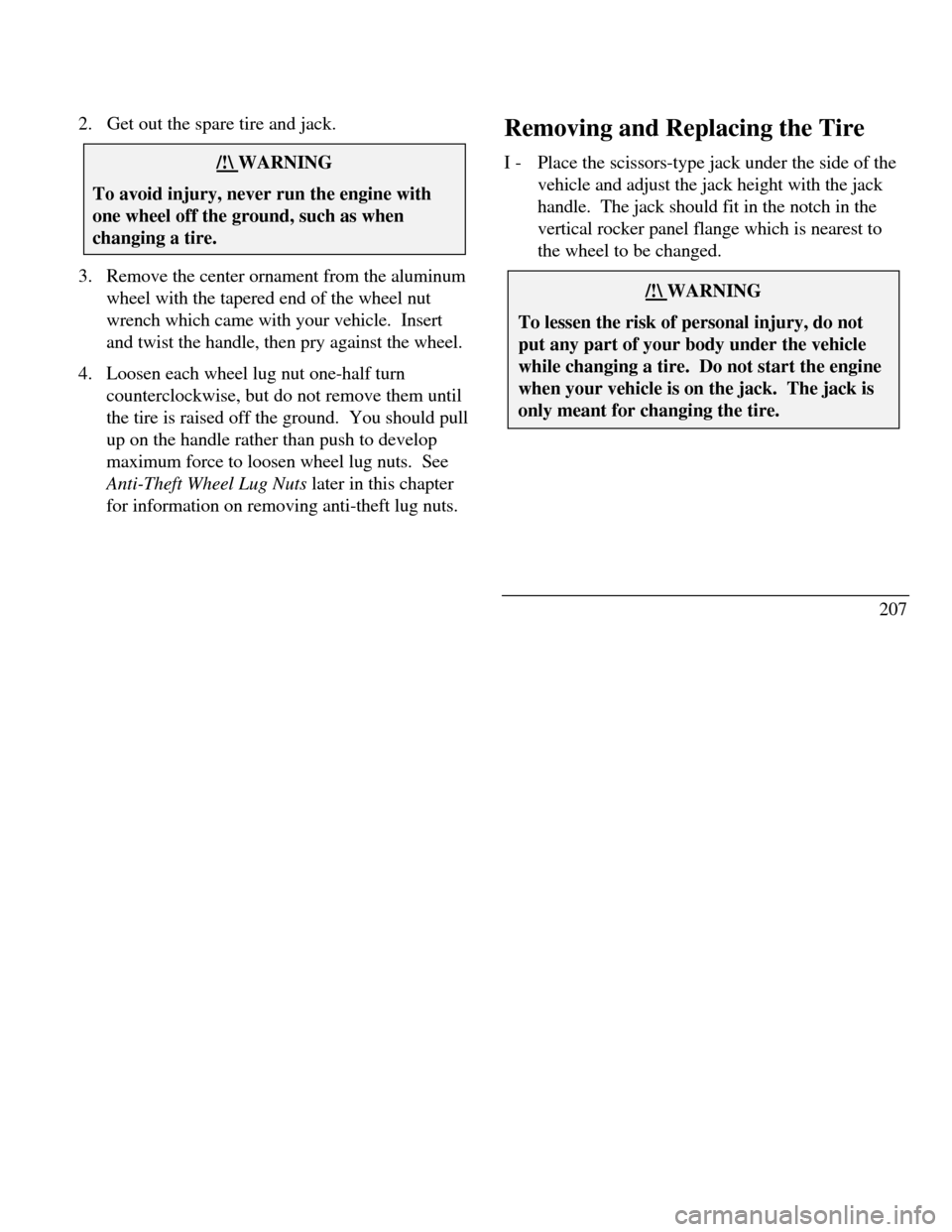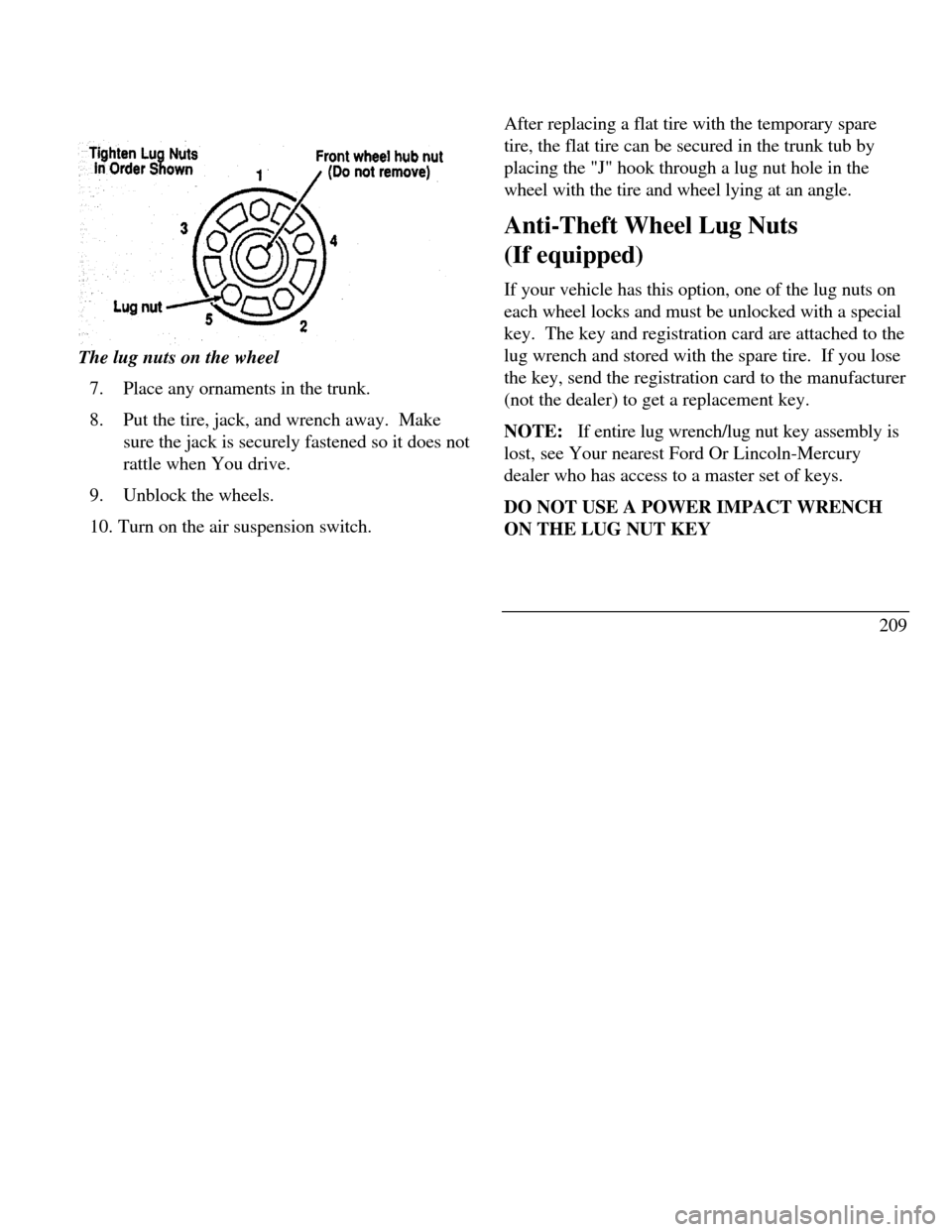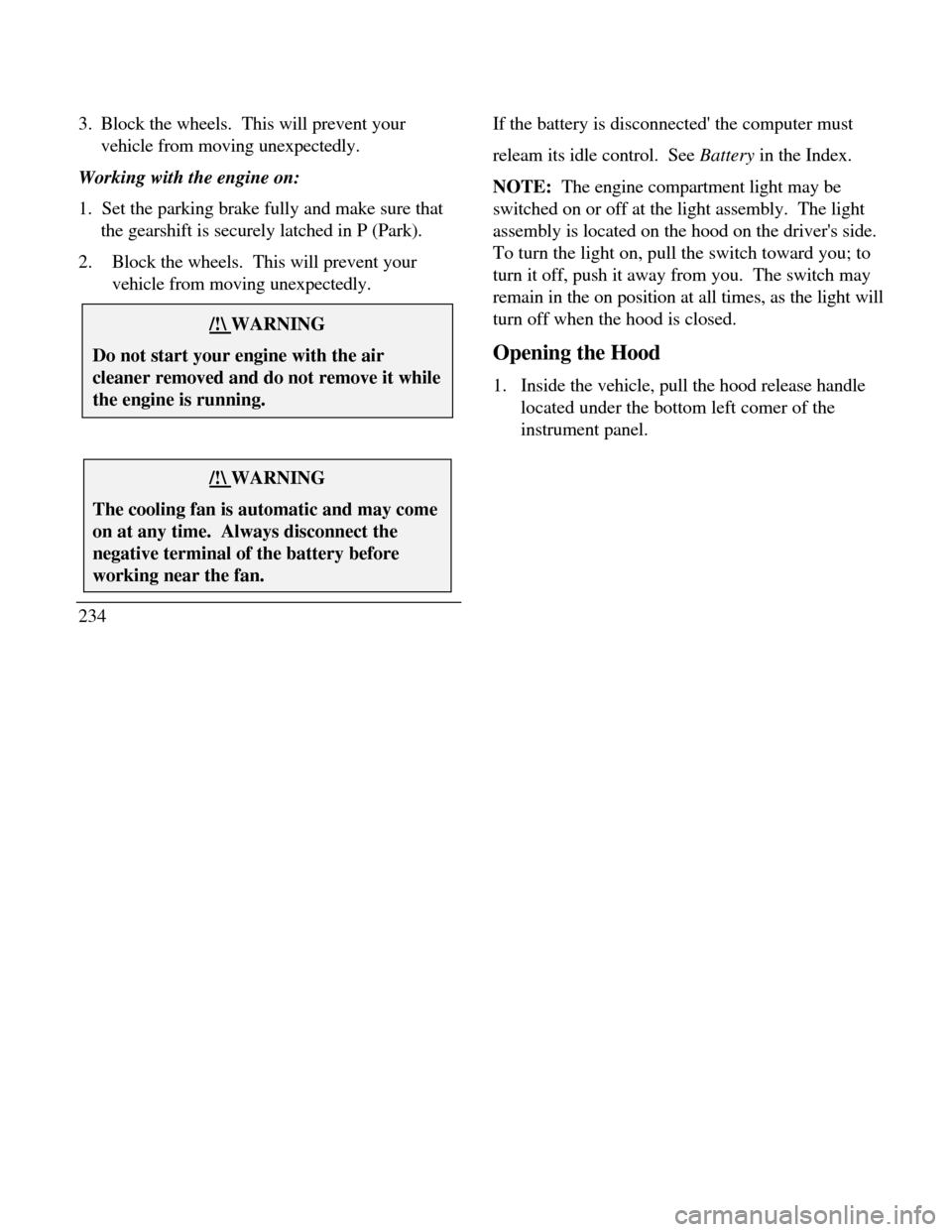Page 210 of 320

2. Get out the spare tire and jack./! WARNINGTo avoid injury, never run the engine withone wheel off the ground, such as whenchanging a tire.3. Remove the center ornament from the aluminum
wheel with the tapered end of the wheel nut
wrench which came with your vehicle. Insert
and twist the handle, then pry against the wheel.
4. Loosen each wheel lug nut one-half turn
counterclockwise, but do not remove them until
the tire is raised off the ground. You should pull
up on the handle rather than push to develop
maximum force to loosen wheel lug nuts. See
Anti-Theft Wheel Lug Nuts later in this chapter
for information on removing anti-theft lug nuts.Removing and Replacing the Tire
I -Place the scissors-type jack under the side of the
vehicle and adjust the jack height with the jack
handle. The jack should fit in the notch in the
vertical rocker panel flange which is nearest to
the wheel to be changed./! WARNINGTo lessen the risk of personal injury, do notput any part of your body under the vehiclewhile changing a tire. Do not start the enginewhen your vehicle is on the jack. The jack isonly meant for changing the tire.207
Page 211 of 320
The notches for the jack
2082. Turn the jack handle clockwise until the wheel
clears the ground. Remove the wheel lug nuts.
3. Replace the flat tire with the spare tire, making
sure that the air valve stem is facing outward.
4. Reinstall the lug nuts, tightening until the wheel is
snug against the hub. The beveled edges on the
lug nuts face inward. Do not fully tighten the lug
nuts until you lower the vehicle. If you do, you
could force the vehicle off the jack.
5. Lower the vehicle by turning the jack handle
counterclockwise.
6. Remove the jack and fully tighten the lug nuts in
the order shown in the following illustration. As
soon as possible, have your dealer or a qualified
service technician check the lug nuts for proper
torque specifications.
7.
8.
Page 212 of 320

9. Lug nutThe lug nuts on the wheel
7.Place any ornaments in the trunk.
8.Put the tire, jack, and wrench away. Make
sure the jack is securely fastened so it does not
rattle when You drive.
9.Unblock the wheels.
10. Turn on the air suspension switch.After replacing a flat tire with the temporary spare
tire, the flat tire can be secured in the trunk tub by
placing the "J" hook through a lug nut hole in the
wheel with the tire and wheel lying at an angle.
Anti-Theft Wheel Lug Nuts
(If equipped)
If your vehicle has this option, one of the lug nuts on
each wheel locks and must be unlocked with a special
key. The key and registration card are attached to the
lug wrench and stored with the spare tire. If you lose
the key, send the registration card to the manufacturer
(not the dealer) to get a replacement key.
NOTE: If entire lug wrench/lug nut key assembly is
lost, see Your nearest Ford Or Lincoln-Mercury
dealer who has access to a master set of keys.
DO NOT USE A POWER IMPACT WRENCH
ON THE LUG NUT KEY
209
Page 214 of 320
Towing Your Vehicle
If you need to have your vehicle towed, contact a
professional towing service or, if you are a member,
your roadside assistance center. Typical towing
options include wheel lift towing or flat bed towing.Front towingRear towing
When calling for a tow truck, tell the operator what
kind of vehicle you have. A towing manual is
available from Ford Motor Company for 0 authorized
tow truck operators. Have your tow truck driver
refer to this manual for the proper hook-up and
towing procedures for your vehicle.
211
Page 227 of 320
Travel
Heavy-duty battery
Comfort and convenience
Engine block heater
Cargo net
224Protection and appearance
Carpeted floor mats
Cleaners, waxes and polishes
Styled wheel protector locks
Super Seal undercoating (in U.S. only)
Touch-up paints
Vinyl protectant
Wheel splash guards (flat)
Vehicle security system
Page 236 of 320

3.Block the wheels. This will prevent your
vehicle from moving unexpectedly.
Working with the engine on:
1. Set the parking brake fully and make sure that
the gearshift is securely latched in P (Park).
2.Block the wheels. This will prevent your
vehicle from moving unexpectedly./! WARNINGDo not start your engine with the aircleaner removed and do not remove it whilethe engine is running./! WARNINGThe cooling fan is automatic and may comeon at any time. Always disconnect thenegative terminal of the battery beforeworking near the fan.234If the battery is disconnected' the computer must
releam its idle control. See Battery in the Index.
NOTE: The engine compartment light may be
switched on or off at the light assembly. The light
assembly is located on the hood on the driver's side.
To turn the light on, pull the switch toward you; to
turn it off, push it away from you. The switch may
remain in the on position at all times, as the light will
turn off when the hood is closed.
Opening the Hood
1. Inside the vehicle, pull the hood release handle
located under the bottom left comer of the
instrument panel.
Page 261 of 320

Treadwear
The treadwear grade is a comparative rating based
on the wear rate of the tire when tested under
controlled conditions on a specified government test
course. For example, a tire graded 150 would wear
one and one-half (1 1/2) times as well on the
government course as a tire graded 100. The
relative performance of tires depends upon the
actual conditions of their use, however, and may
depart significantly from the norm due to variations
in driving habits, service practices and differences in
road characteristics and climate.
Traction A B C
The traction grades, from highest to lowest, are A, B,
and C, and they represent the tire's ability to stop on
wet pavement as measured under controlled
conditions on specified government test surfaces of
asphalt and concrete. A tire marked C may have
poor traction performance. Warning: The traction
grade assigned to this tire is based on braking(straightahead) traction tests and does not include
cornering (turning) traction.
Temperature A B C
The temperature grades are A (the highest), B, and
C, representing the tire's resistance to the generation
of heat and its ability to dissipate heat when tested
under controlled conditions on a specified indoor
laboratory test wheel. Sustained high temperature
can cause the material of the tire to degenerate and
reduce tire life, and excessive temperature can lead
to sudden tire failure. The grade C corresponds to a
level of performance which all passenger car tires
must meet under the Federal Motor Vehicle Safety
Standard No. 109. Grades B and A represent higher
levels of performance on the laboratory test wheel
than the minimum required by law. Warning: The
temperature grade for this tire is established for a tire
that is properly inflated and not overloaded.
Excessive speed, underinflation, or excessive
259
Page 262 of 320

loading, either separately or in combination, can
cause heat buildup and possible tire failure.
Snow tires
The tires on your vehicle have all-weather treads
that provide traction in rain or snow. However,
during the winter months in some climates, you may
need to use snow tires.
Use of tire chains is not recommended. The use of
tire chains could result in damage to your vehicle./!\ WARNINGSnow tires must be the same size and gradeas the tires you Currently have on yourvehicle.Cleaning the Wheels
Wash the wheels with the same detergent you use
to wash your vehicle's body. Do not use acid-based
wheel cleaners, steel wool, abrasives, fuel, or strong
260detergents. These substances will damage protective
coatings. Use tar and road oil remover to remove
grease and tar.
NOTE: Before going to a car wash, find out if the
brushes are abrasive.
If you have whitewall tires that are difficult to clean
with regular detergent, use whitewall tire cleaner.
Follow the directions on the container and rinse the
tires with plenty of clean water.
Securitires (If equipped)
Securitires are designed to allow you to continue
driving your Continental a limited number of miles
when one of your vehicle's tires is at low or even
zero air pressure./!\ WARNINGDo not use aerosol tire inflator/sealer withSecuritires. Doing so may damage the tire'spressure sensor.